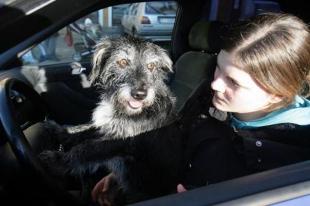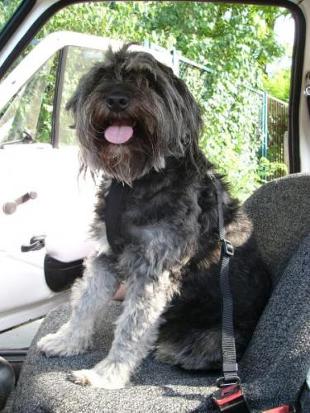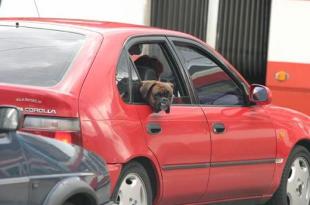
How to transport pets in a car
 Going on a trip with your pet, you should always properly prepare for it. Depending on the size, the animal needs a suitable carrier - not only so that it can survive a possible car accident, but also so that it does not harm the people riding in the vehicle.
Going on a trip with your pet, you should always properly prepare for it. Depending on the size, the animal needs a suitable carrier - not only so that it can survive a possible car accident, but also so that it does not harm the people riding in the vehicle.
There are many things to consider when preparing to transport your pet.  aspects that will make your journey safe. It doesn't matter if we are dealing with a 3 kg cat or a 50 kg dog.
aspects that will make your journey safe. It doesn't matter if we are dealing with a 3 kg cat or a 50 kg dog.
READ ALSO
Animal on board
Encounter with a boar
It often happens that a dog or cat is transported without any protection, often in the passenger seat at the front of the car, or roam freely around the car. The consequences of this can be very dangerous for both animals and people, for example, when a cat or other small animal suddenly gets under the gas or brake pedal.
Unfortunately, many people refuse cages or transporters because they associate them with captivity and mistreatment of animals. Nothing could be more wrong! Such special transport cages can effectively protect animals and people traveling in a car. An animal sitting freely in the back or front can injure itself and people in the car even in a minor collision.
The laws of physics are merciless: at the moment of a collision at a speed of 50 km / h, the accelerations acting on car passengers can reach values from 20 to 30 g. This means that at the moment of a collision a cat or dog weighing 3,1 kg can “weigh” as much as 93 kg. The "bullet" it becomes can deal unpredictable damage. That's why it's so important to properly secure traveling pets.
Traveling by car is a big test for our pet. The roar of the engine, high temperatures and ever-changing smells are sure to stress the animals and make driving uncomfortable.
 So, what can be done to minimize these negative impressions, and at the same time increase the safety of all car drivers:
So, what can be done to minimize these negative impressions, and at the same time increase the safety of all car drivers:
– The animal should only be transported in a special carrier or cage which is designed for the transport of animals and which must be large enough for the animal to lie freely and placed in the vehicle in a place that will make it stable, i.e. when braking hard, they did not move around the car.
– The best solution is to install a grille strong enough to effectively separate space for passengers and luggage. It will not only protect the pet from getting inside, but also protect passengers from luggage in case of an accident.
– If the animal is large, the luggage space must be in the roof rack.
– If the animal is medium or small, the trunk can be divided in half by a second grate – a place for luggage and a place for the animal.
– If there is no grid, then you can put a transporter or a cage in the trunk, but do not forget to attach them “hard”
– The small conveyor can be placed on the floor behind the driver's or passenger's front seat, pressed against the front seat, or on the front of the floor, at the passenger's feet, also pressed against the seat.
- In station wagons, vans or hatchbacks, the animal is transported in the trunk, which should not be closed by a shelf at the top so that the animal can breathe and is not afraid of a small dark space.
- Do not feed your pet a few hours before the trip, as stress can cause problems with the digestive system. This should be taken into account, especially if he suffers from motion sickness.
If we travel many kilometers, stops are a must. Every 2-3 hours, small breaks should be taken, during which the pet can take care of its physiological needs, drink water or go for a walk.
When standing on the side of the road, remember that the animal must be released on a leash or in a harness from the side of the sidewalk so as not to endanger its safety or other road users.
As owners, we are responsible for our pets. We must do our best to make the journey as stress-free as possible for them and as safe as possible for them and for the people. Therefore, during the movement, the pet must be locked in a special transport for animals, which must be well secured, stresses trainer Bartosz Buksha.
READ ALSO
Encountering an animal too close
Did you hit an animal? You will not receive any compensation
The temperature inside the car must be optimal during the journey, and our pet must have constant access to fresh air. Attention! A dog's head sticking out from behind the windshield of a moving car can cause serious illnesses such as eye, ear, and nose infections from too much cold air.
 Even the smallest animals, such as a rabbit or a hamster, should not be transported on your lap or in a cardboard box. To do this, use a suitable transport bag that will allow the animal to move freely. To increase the level of safety, such a mini-container should be fastened with seat belts.
Even the smallest animals, such as a rabbit or a hamster, should not be transported on your lap or in a cardboard box. To do this, use a suitable transport bag that will allow the animal to move freely. To increase the level of safety, such a mini-container should be fastened with seat belts.
Knowing that everything has been done to make the trip as safe as possible for all car occupants is a great sign of responsible and prudent driving. Thanks to this, we also reduce the risk of unpleasant surprises. Proper selection of the conveyor according to the size of the animal, its correct location and fastening in the vehicle, as well as always fastened seat belts - this is peace of mind not only for the driver, but also for four-legged travelers.